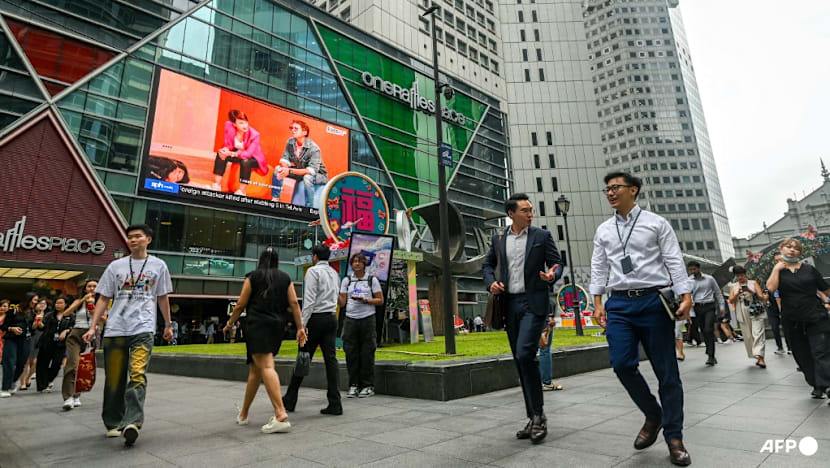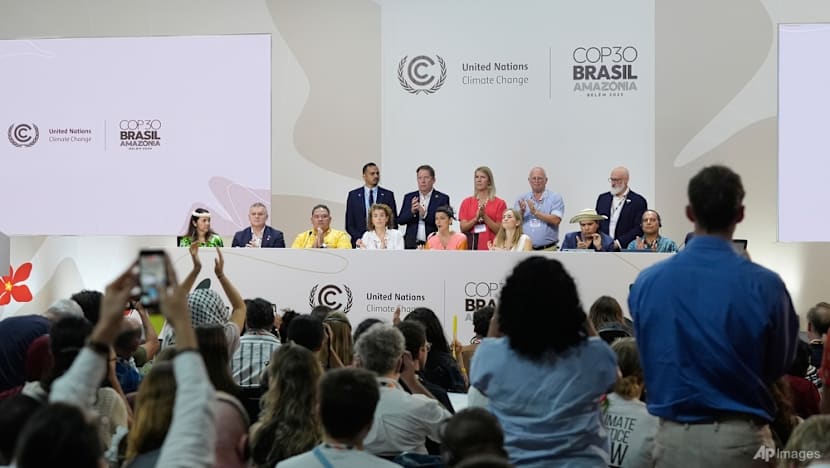Commentary: The wretched business of the ‘smart casual’ dress code
The world’s most confusing dress code is even worse in the steamy COP30 tropics, says the Financial Times’ Pilita Clark.

People walk on the street during lunch break at Raffles Place in Singapore on Jan 22, 2025. (File photo: AFP/Roslan Rahman)
LONDON: Lord Nicholas Stern and Lord Adair Turner are two of the world’s most serious thinkers on climate change policy. But when the two British peers bumped into each other at the United Nations COP30 climate conference in the tropical Brazilian city of Belem, they had another matter to discuss.
“Why are you wearing that jacket?” demanded a shirt-sleeved Turner as a besuited Stern made his way into the muggy confines of the UK delegation pavilion where the pair were speaking at back-to-back events.
It was a reasonable question.
COMFORT AND WELL-BEING IN SWELTERING HEAT
Temperatures in parts of the unevenly air-conditioned venue had by this stage soared to such heights that the UN had told Brazil’s organisers action was “urgently required to safeguard the well-being of delegates”.

A carbon markets meeting was disrupted when a sweaty delegate trying to leave his plastic chair discovered the backs of his thighs had been welded in place with what one journalist present described as “the force of a thousand post-beach car seats”.
In a noisy lurch to wrench himself free, the delegate’s paperwork went flying, while others who tried to leave their sticky seats made such a racket the chair called for future sessions to include seat covers.
To an extent, this was part of the plan. Brazil’s President Luiz Inacio Lula da Silva insisted a conference on the edge of the Amazon rainforest would show the world what life was like on a warming planet.
In keeping with this theme, Lula’s government issued official advice that formal business attire was not needed and “to ensure everyone’s comfort, the recommended dress code for the COP30 is smart casual”.
ILL-DEFINED TO THE POINT OF USELESSNESS
Alas, this proved less than helpful. Stern was one of multiple attendees who turned up in a suit, in his case an M&S navy linen number, at an event to discuss his new climate book, The Growth Story Of The 21st Century.
He agreed the forbidding heat made the case for this wardrobe choice thin, but as he told me later, when it comes to smart casual: “I never know what it means”.
This was news to me. I knew that for women, the idea of smart casual, or the equally confusing business casual, is ill-defined to the point of uselessness.
But I had always assumed it helped men, since it at least suggested there was no need for a tie, an item Lula cheerfully dispensed with as the COP got under way.
It turned out ties were the least of the problems for men in Belem, where the 30 degrees Celsius-plus temperatures posed a number of sartorial perils, starting with shirt buttons.
Andre Correa do Lago, the polished Brazilian diplomat presiding over the COP talks, and Wopke Hoekstra, the EU’s Dutch climate commissioner, both interpreted smart casual to mean you could leave not just one but two top shirt buttons undone. This seemed eminently sensible to me but left others visibly dismayed. “I mean, you can see actual chest hair,” one male participant said.
JACKETS AS A SYMBOL OF RESPECTABILITY
I suppose reactions like this explain the vexing matter of the jacket, an item Turner deems an illogical “totem pole of respectability”, even in cooler climes.
Men set off to meetings in a jacket that makes them too hot, he told me, so they take it off and carry it until they can put it on the back of a chair, where they leave it until it’s time to leave. “It’s bizarre.”
Personally, I have always envied the way a man can use a jacket like a mobile handbag, stuffing its pockets with his wallet, phone and keys. In places like Belem though, the jacket made zero sense.
Still, things have been worse at these conferences. Although the general state of COP attire tends to veer more towards the casual than the smart, there are limits.
Some years ago at a COP in Poland, an adviser to developing country delegates lashed out at negotiators from Australia, then led by Prime Minister Tony Abbott, a critic of robust climate action.
The adviser said Australians were not just being unnecessarily obstructive in the talks, they were also giggling, insensitive, and “wearing T-shirts”. They may have been ahead of their time.
In sweltering Belem last week, a T-shirt was the height of common dress sense. Cool, light and notably, capable of covering the most unruly type of chest hair.











